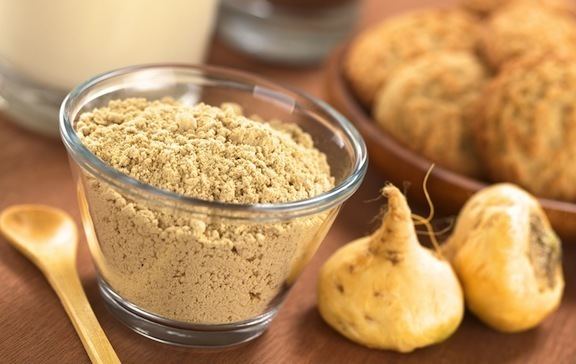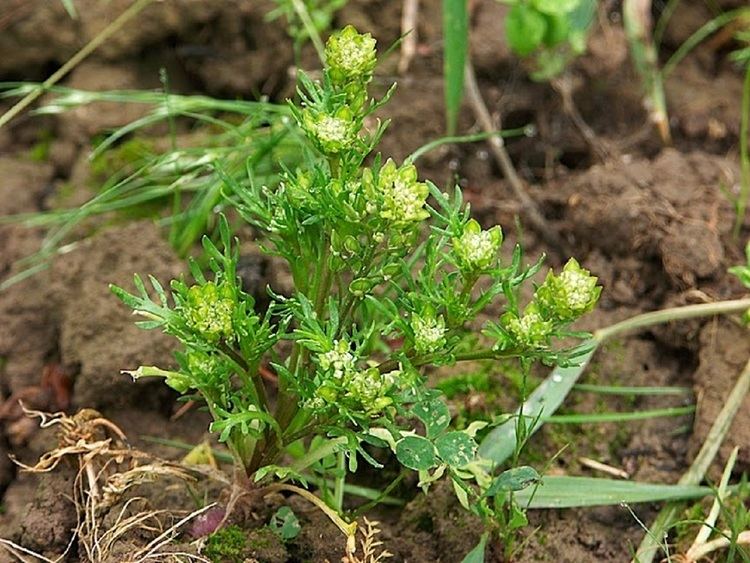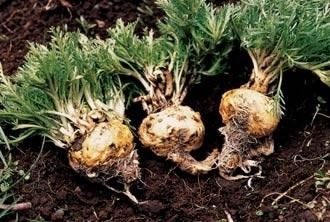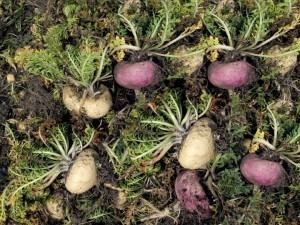Genus Lepidium Rank Species | ||
 | ||
Similar Bindii, Asian Ginseng, Lepidium, Barrenwort, Guarana | ||
Lepidium meyenii (maca) is an herbaceous biennial plant of the crucifer family native to the high Andes of Peru. It was found at the Meseta of BomBom close to Junin Lake in the Andes. It is grown for its fleshy hypocotyl (a fused hypocotyl and taproot), which is used as a root vegetable and a medicinal herb. Its Spanish and Quechua names include maca-maca, maino, ayak chichira, and ayak willku.
Contents
- Botanical characteristics
- Root
- Growth conditions
- Cultivation
- Constituents
- Uses and preparation
- Health effects
- Aphrodisiac claims
- Womens Health
- Marketing potential
- References

Botanical characteristics

The first westerner to describe this species was Gerhard Walpers who named it Lepidium meyenii in 1843. In the 1990s, Gloria Chacon made a further distinction of different species. She considered the widely cultivated natural maca of today to be a newer domesticated species, L. peruvianum. Most botanists today doubt this distinction, however, and continue to call the cultivated maca L. meyenii. The Latin name recognized by the USDA also continues to be Lepidium meyenii. Debate is still ongoing about the correct nomenclature and whether the distinction between meyenii and peruvianum is botanically correct.

The growth habit, size, and proportions of maca are roughly similar to those of radishes and turnips, to which it is related. The green, fragrant tops are short and lie along the ground. The thin, frilly leaves sprout in a rosette at the soil surface, not growing more than 12–20 cm (4.7–7.9 in) in height. The leaves show a dimorphism according to reproductive stage. They are more prominent in the vegetative phase, and are continuously renewed from the center as the outer leaves die. The off-white, self-fertile flowers are borne on a central raceme, and are followed by 4–5 mm (0.16–0.20 in) siliculate fruits, each containing two small 2.0–2.5 mm (0.079–0.098 in) reddish-gray ovoid seeds. Seeds are the maca’s only means of reproduction. Maca reproduces mainly through self-pollination and is an autogamous species. The genome consists of 64 chromosomes. From experiments with different day lengths, maca is a short-day plant. Some sources consider the maca to be an annual plant, as in favorable years it can complete a lifecycle within a year.
Root

Maca is the only member of its genus with a fleshy hypocotyl, which is fused with the taproot to form a rough inverted pear-shaped body. Maca does vary greatly in the size and shape of the root, which may be triangular, flattened circular, spherical, or rectangular, the latter of which forms the largest roots. Maca hypocotyls may be gold or cream, red, purple, blue, black, or green. Each is considered a "genetically unique variety", as seeds of the parent plants grow to have roots of the same color. Recently, specific phenotypes (in maca, 'phenotype' pertains mainly to root color) have been propagated exclusively to ascertain their different nutritional and therapeutic properties. Cream-colored roots are the most widely grown and are favored in Peru for their enhanced sweetness and size.

Darker-colored maca roots (red, purple, black) contain significant amounts of natural iodine that may avoid the growth of goiters resulting from consumption of the lighter-colored maca. Black maca is considered the strongest in energy and stamina-promoting properties, being both sweet and slightly bitter in taste. Red maca is becoming popular with many people, and has been shown in laboratory experiments to reduce prostate size in rats.
Growth conditions

The natural environment of the maca is at 11-12ºS latitude and at an elevation of 3,800–4,400 m (12,500–14,400 ft) above sea level. At this elevation, temperatures of the growing season vary from −2 to 13 °C (28 to 55 °F) in monthly mean minimum or maximum, respectively. Temperatures can decline, however, as low as −10 °C (14 °F) and frosts are common. Strong winds and sunlight also are characteristics of the native habitat of the maca. Maca today is still mainly cultivated in Peru, in the high Andes of Bolivia, and to a small extent also in Brazil.
Cultivation
Maca (Peruvian Ginseng) seedlings usually emerge about one month after sowing with the onset of the rainy season in October. In the vegetative phase, until May to June, the lower part of the hypocotyl, as well as the upper part of the tap root, grows in size. After 260 to 280 days, it is formed to the harvestable hypocotyl. If the root is left in the soil, it is dormant for two to three months in the time of the cold, dry season until August. Then it will form a generative shoot on which the seeds ripen five months later. One plant is capable of forming up to 1000 tiny seeds, 1600 of which weigh about one gram. Thus, only relatively few plants are needed for propagation. The plants for cultivation are selected for preferred size and color, then placed 50–100 mm deep in pits with alternate layers of grass and soil to protect them from drying out. They are fertilized heavily. The cultivation cycle is strictly linked to seasonality.
Traditionally, land preparation was done by hand. Nowadays, tractor plowing also is used. As maca grows on sites where no other crops can be cultivated, it is often found after long fallows of sheep grazing pastures. Maca croplands thus traditionally are only fertilized with sheep and alpaca manure; however, fertilizer application could prevent soils from depleting in nutrients.
Weeding or pesticide application usually is not necessary as the climate is not suitable for most weeds or pests. Nearly all maca cultivation in Peru is carried out organically, as maca itself is seldom attacked. Maca is sometimes interplanted with potatoes, as it is known to maca farmers that the plant naturally repels most root crop pests.
The harvest is done manually, with the leaves left on the field as livestock feed or organic fertilizer.
The yield for a cultivated hectare may reach an estimated 15 tons in fresh hypocotyls resulting in around 5 tons of dried material. According to the Ministry of Agriculture of Peru, however, average maca yields for 2005 were only 7 t/ha, with a great variation between different sites. Although maca has been cultivated outside the Andes, it is not yet clear whether it develops the same active constituents or potency outside of its natural habitat. Hypocotyls grown from Peruvian seeds form with difficulty at low elevations, in greenhouses, or in warm climates.
Constituents
The nutritional value of dried maca root is high, similar to cereal grains such as rice and wheat. The average composition is 60-75% carbohydrates, 10-14% protein, 8.5% dietary fiber, and 2.2% fats. Maca is rich in the dietary minerals calcium and potassium (with low content of sodium), and contains the essential trace elements iron, iodine, copper, manganese, and zinc, as well as fatty acids including linolenic acid, palmitic acid, and oleic acids, and 19 amino acids.
In addition to sugars and proteins, maca contains uridine, malic acid, and its benzoyl derivative, and the glucosinolates, glucotropaeolin and m-methoxyglucotropaeolin. The methanol extract of maca tuber also contains (1R,3S)-1-methyltetrahydro-carboline-3-carboxylic acid, a molecule which is reported to exert many activities on the central nervous system. Many different alkamides were found in maca.
Further, maca contains selenium and magnesium, and includes polysaccharides. Maca's reported beneficial effects for sexual function could be due to its high concentration of proteins and vital nutrients; maca contains a chemical called p-methoxybenzyl isothiocyanate, which reputedly has aphrodisiac properties.
Uses and preparation
Maca is mainly grown for the nutritional and health value of its root. The majority of harvested maca is dried. In this form, the hypocotyls can be stored for several years. In Peru, maca is prepared and consumed in various ways, although traditionally it is always cooked. The freshly harvested hypocotyl may be roasted in a pit (called huatia), and is considered a delicacy. Fresh roots usually are available only in the vicinity of the growers. The root also can be mashed and boiled to produce a sweet, thick liquid, then dried and mixed with milk to form a porridge. The cooked roots are also used with other vegetables in empanadas, jams, or soups. The root may be ground to produce a flour for bread, cakes, or pancakes. If fermented, a weak beer called chicha de maca may be produced. In 2010, a U.S.-based brewery called Andean Brewing Company, became the first company to produce and commercialize beer made from maca under the brand KUKA Beer. From the black morphotype, a liquor is produced. Also, the leaves are edible or may serve as animal fodder. They can be prepared raw in salads or cooked much like Lepidium sativum and L. campestre, to which it is closely related genetically.
The growing demand of the supplement industry has been one of the primary reasons for maca's expanding cultivation in Peru and Bolivia. The prominent product for export is maca flour, which is a baking flour ground from the hard, dried roots. It is called harina de maca. Maca flour (powder) is a relatively inexpensive bulk commodity, much like wheat flour or potato flour. The supplement industry uses both the dry roots and maca flour for different types of processing and concentrated extracts. Another common form is maca processed by gelatinization. This extrusion process separates and removes the tough fiber from the roots using gentle heat and pressure, as raw maca is difficult to digest due to its thick fibers and goitrogen content. Gelatinization was developed for maca specifically to mimic the activity of cooking, and to allow gentler digestion. Gelatinized maca is employed mainly for therapeutic and supplement purposes, but also can be used like maca flour, as a flavor in cooking. Available also is a freeze-dried maca juice, which is squeezed from the macerated fresh root, and subsequently freeze-dried high in the Andes.
Maca has been harvested and used by humans in the Andean Mountains for centuries. Contrary to frequent claims that maca's cultivation was common in what is today Peru, until the late 1980s, maca has been cultivated only in a limited area around Lake Junin, in central Peru. Historically, maca often was traded for lowland tropical food staples, such as corn, rice, manioc (tapioca roots), quinoa, and papaya. It also was used as a form of payment of Spanish imperial taxes. Maca was eaten by Inca imperial warriors before battles. Their legendary strength was allegedly imparted by the preparatory consumption of copious amounts of maca, fueling formidable warriors. After a city was conquered, the women had to be protected from the Inca warriors, as reportedly they became ambitiously virile from eating such quantities of maca. This is an endorsement for the masculine angle of maca's recent marketing campaign. Whether or not this often-repeated legendary use is true has yet to be determined. Those who have studied maca's history have not been able to locate formal mention of this particular use historically.
Health effects
Maca is consumed as food for humans and livestock, suggesting any risk from consumption is rather minimal. It is considered as safe to eat as any other vegetable food, but maca does contain glucosinolates, which can cause goiters when high consumption is combined with a diet low in iodine. However, darker-colored maca roots (red, purple, black) contain significant amounts of natural iodine, a 10-gram serving of dried maca generally containing 52 µg of iodine.
Aphrodisiac claims
Maca has been marketed for its supposed benefits for sexual performance, although there is insufficient evidence to show that it helps with sexual or erectile dysfunction in older people. Evidence of aphrodisiac properties is limited by small study sizes and scientific evidence on its effectiveness is limited.
Women's Health
In the United States, maca is promoted as a dietary supplement for several women's health issues, including symptoms of menopause. A systemic review published in 2011 found few rigorous clinical trials, and that even those were difficult to interpret; the safety and efficacy of maca for alleviating menopause symptoms is not known.
Marketing potential
Due to its purported effects on fertility, maca has experienced a major gain of commercial interest, as well as research in the last few decades. In the 1990s, a quick expansion of cultivated land with maca was seen. As the demand rose rapidly, the producer’s prices increased. Due to high expectations, however, the production expanded too rapidly and in the year 2000 prices fell again.
Market studies have shown a very low acceptance of the particular maca taste in consumers when first exposed to it. Apparently, the taste is acquired, which creates a barrier for the further propagation of this food as a vegetable. The economic interest lies hence more in the medical application of the root's constituents.
In recent years, maca has been grown in China, and Peru has recently accused Chinese companies of illegally exporting maca from Peru and biopiracy, as they have applied for several patents on the plant.
